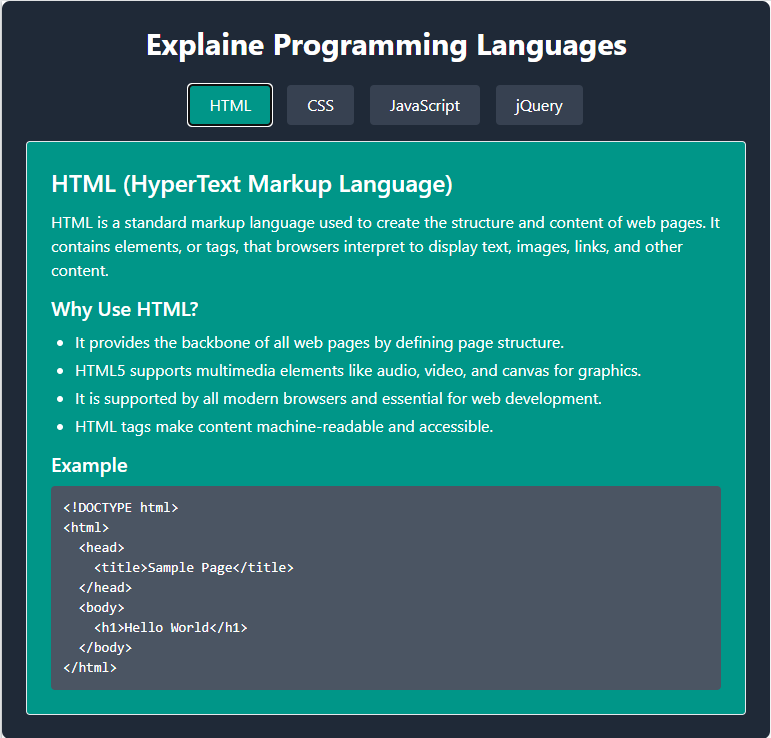Explaine Programming Languages
Explore the core technologies of every modern website in an interactive and easy-to-use guide.
Whether you’re new to web development or want to brush up on your basics, this interactive, tab-based guide is a great place to start. It combines the four essential tools for front-end development – HTML, CSS, JavaScript, and jQuery – into a simple, clean interface that makes learning easier and more engaging.
Each tab has a clear explanation of what the language is, how it works, and why it’s important in the development process. You’ll get practical insights, beginner-friendly breakdowns, and real-world code examples that show you how these technologies are used in real websites.
Whether you’re a student, a coding enthusiast, or someone preparing for a future in technology, this guide will help you understand how the web is built, step by step. Powered by Tailwind CSS and jQuery, this project shows you how you can design responsive and interactive interfaces with minimal effort.
This is more than just a reference – it’s a launchpad for your journey into web development.
<!DOCTYPE html>
<html lang="en" class="transition-all duration-300">
<head>
<meta charset="UTF-8" />
<meta name="viewport" content="width=device-width, initial-scale=1" />
<title>Explaine Programming Languages</title>
<script src="https://cdn.tailwindcss.com"></script>
<script src="https://code.jquery.com/jquery-3.6.0.min.js"></script>
</head>
<body>
<div class="w-full max-w-3xl bg-white dark:bg-gray-800 shadow-md rounded-lg p-6">
<h1 class="text-3xl text-white font-bold text-center mb-6">Explaine Programming Languages</h1>
<!-- Tabs -->
<div class="flex flex-wrap gap-4 mb-4 justify-center">
<button class="tab-btn active-tab px-5 py-2 rounded bg-blue-600 text-white" data-tab="html">HTML</button>
<button class="tab-btn px-5 py-2 rounded bg-gray-300 text-gray-900 dark:bg-gray-700 dark:text-white" data-tab="css">CSS</button>
<button class="tab-btn px-5 py-2 rounded bg-gray-300 text-gray-900 dark:bg-gray-700 dark:text-white" data-tab="js">JavaScript</button>
<button class="tab-btn px-5 py-2 rounded bg-gray-300 text-gray-900 dark:bg-gray-700 dark:text-white" data-tab="jquery">jQuery</button>
</div>
<!-- Content -->
<div id="tab-content" class="p-6 border rounded bg-gray-50 dark:bg-[#009688] dark:text-white min-h-[260px]">
<!-- content inserted by JS -->
</div>
</div>
<script>
const languageDetails = {
html: `
<h2 class="text-2xl font-semibold mb-3">HTML (HyperText Markup Language)</h2>
<p class="mb-3">
HTML is a standard markup language used to create the structure and content of web pages. It contains elements, or tags, that browsers interpret to display text, images, links, and other content.
</p>
<h3 class="text-xl font-semibold mb-2">Why Use HTML?</h3>
<ul class="list-disc pl-6 mb-3 space-y-1">
<li>It provides the backbone of all web pages by defining page structure.</li>
<li>HTML5 supports multimedia elements like audio, video, and canvas for graphics.</li>
<li>It is supported by all modern browsers and essential for web development.</li>
<li>HTML tags make content machine-readable and accessible.</li>
</ul>
<h3 class="text-xl font-semibold mb-2">Example</h3>
<pre class="bg-gray-200 dark:bg-gray-600 p-3 rounded text-sm overflow-x-auto"><code><!DOCTYPE html>
<html>
<head>
<title>Sample Page</title>
</head>
<body>
<h1>Hello World</h1>
</body>
</html></code></pre>
`,
css: `
<h2 class="text-2xl font-semibold mb-3">CSS (Cascading Style Sheets)</h2>
<p class="mb-3">
CSS is a stylesheet language used to describe the presentation and design of HTML elements on web pages.
It controls layout, colors, fonts, spacing, and visual effects to improve the user experience.
</p>
<h3 class="text-xl font-semibold mb-2">Why Use CSS?</h3>
<ul class="list-disc pl-6 mb-3 space-y-1">
<li>Separates content (HTML) from design (CSS) for cleaner code management.</li>
<li>Enables responsive design for multiple screen sizes and devices.</li>
<li>Supports animations, transitions, and complex layouts with Flexbox and Grid.</li>
<li>Improves accessibility and readability by controlling visual hierarchy.</li>
</ul>
<h3 class="text-xl font-semibold mb-2">Example</h3>
<pre class="bg-gray-200 dark:bg-gray-600 p-3 rounded text-sm overflow-x-auto"><code>body {
background-color: #f0f0f0;
font-family: Arial, sans-serif;
color: #333;
}
h1 {
color: #0055cc;
margin-bottom: 20px;
}</code></pre>
`,
js: `
<h2 class="text-2xl font-semibold mb-3">JavaScript</h2>
<p class="mb-3">
JavaScript is a powerful programming language used to create dynamic, interactive effects within web browsers. It helps developers manipulate page content, handle events, communicate with servers, and build complex web applications.
</p>
<h3 class="text-xl font-semibold mb-2">Why Use JavaScript?</h3>
<ul class="list-disc pl-6 mb-3 space-y-1">
<li>Enables interactive elements like sliders, form validation, and modal windows.</li>
<li>Supports asynchronous programming (AJAX) to update parts of a page without reloading.</li>
<li>Used in front-end frameworks like React, Angular, and Vue.js.</li>
<li>Can be used on the server side with Node.js for full-stack development.</li>
</ul>
<h3 class="text-xl font-semibold mb-2">Example</h3>
<pre class="bg-gray-200 dark:bg-gray-600 p-3 rounded text-sm overflow-x-auto"><code>document.getElementById('btn').addEventListener('click', function() {
alert('Button clicked!');
});</code></pre>
`,
jquery: `
<h2 class="text-2xl font-semibold mb-3">jQuery</h2>
<p class="mb-3">
jQuery is a fast, small, and feature-rich JavaScript library that simplifies HTML document traversal, event handling, animation, and Ajax interaction for rapid web development.
</p>
<h3 class="text-xl font-semibold mb-2">Why Use jQuery?</h3>
<ul class="list-disc pl-6 mb-3 space-y-1">
<li>Simplifies complex JavaScript code with easy-to-use syntax.</li>
<li>Offers cross-browser compatibility, handling inconsistencies gracefully.</li>
<li>Provides powerful utilities for DOM manipulation, event handling, and effects.</li>
<li>Has a large plugin ecosystem to extend functionality.</li>
</ul>
<h3 class="text-xl font-semibold mb-2">Example</h3>
<pre class="bg-gray-200 dark:bg-gray-600 p-3 rounded text-sm overflow-x-auto"><code>$('#btn').click(function() {
alert('Button clicked!');
});</code></pre>
`
};
// Function to switch tabs
function activateTab(tabName) {
$('.tab-btn').removeClass('bg-blue-600 text-white').addClass('bg-gray-300 text-gray-900 dark:bg-gray-700 dark:text-white');
$(`.tab-btn[data-tab="${tabName}"]`).addClass('bg-[#009688] text-white').removeClass('bg-gray-300 text-gray-900 dark:bg-gray-700 dark:text-white');
$('#tab-content').html(languageDetails[tabName]);
}
// On page load, activate HTML tab by default
$(document).ready(function() {
activateTab('html');
});
// On tab click
$('.tab-btn').click(function() {
const tab = $(this).data('tab');
activateTab(tab);
});
</script>
</body>
</html>
